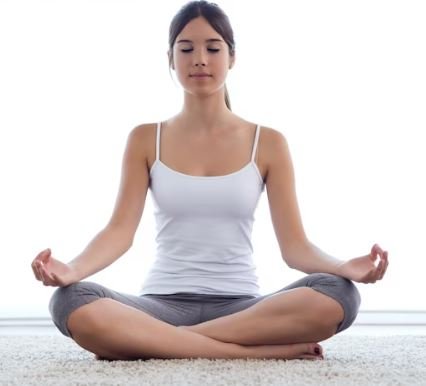Meditation

Introduction:
- Focusing the mind, reaching a level of profound relaxation, and increasing awareness are all part of the practice of meditation. Its roots can be found in ancient civilizations including Greece, China, and India, giving it a wealth of historical value. It has been practiced for spiritual development, self-discovery, and obtaining inner harmony and tranquilly throughout history.
- There are several reasons why it has become so popular in the present era. It is becoming more and more popular as a means of stress management, mental health, and general health improvement. The increased popularity of meditation can be attributed to a number of factors, including growing awareness of mindfulness practices, internet and app accessibility, and scientific research proving the advantages. The fact that it can be adapted to a variety of lifestyles and is widely promoted by influencers and celebrities also contributes to its popularity.
- This blog post’s goal is to examine the advantages and importance of this in contemporary society. Expect to learn about the history, benefits, and increasing acceptance of meditation in modern society, along with the numerous mental, emotional, and physical benefits of consistent practice. The article will explore the various benefits of this, including how it can lower stress and promote better focus and concentration, emotional control, and general wellbeing.
1.Benefits of Meditation:
1.Physical Benefits:
- Balancing mental and emotional well-being requires lowering stress and anxiety levels. It is a useful tool for reaching this goal. Techniques for meditation can ease mental tension, encourage rest, and lessen the body’s reaction to stress and worry. Frequent practice has been demonstrated to increase emotions of clarity and relaxation as well as general resilience to stressors.
- Improving sleep quality is essential for overall health and well-being. One effective way to achieve this is through meditation. Regular practice has been linked to better sleep quality by helping to calm the mind, reduce stress and anxiety, and promote relaxation. By incorporating into a daily routine, individuals can experience improved sleep patterns, enhanced physical health, and increased mental clarity and focus during waking hours.
- Enhancing immune system function is crucial for maintaining overall health and well-being, especially during challenging times. It has been shown to positively impact the immune system by reducing stress levels, promoting relaxation, and improving overall mental and emotional well-being. Research suggests that regular practice may help boost immune system function by reducing inflammation and supporting immune cell activity. Incorporating meditation into daily life can be a valuable tool for enhancing immune system resilience and overall health.
2.Mental Benefits:
- Leading a healthy and meaningful life requires raising awareness and mindfulness. A potent technique for developing mindfulness and raising general awareness is meditation. Regular practice can help people improve their ability to pay attention in the present, increase their awareness of their thoughts and feelings, and get more insight and clarity. Increased emotional resilience, better decision-making, decreased stress, and a stronger sense of self and the world around one are all possible outcomes of this elevated mindfulness and awareness.
- Enhancing focus and concentration is crucial for productivity and goal achievement. One effective method that can greatly increase attention and concentration is meditation. Regular practice helps people train their minds to reduce distractions, stay in the present moment, and improve cognitive performance. According to research, it may help the brain’s grey matter grow, which is linked to better focus and attention. Including it in your daily practice can improve your focus, mental clarity, and productivity in a variety of areas of your life.
- Effective emotion management is essential to one’s general wellbeing and social interactions. One useful technique that can assist people in better controlling their emotions is meditation. Regular practice can help people become more self-aware, thoughtful, and emotionally resilient. Focused breathing and mindfulness are two examples of meditation approaches that can help with recognising and comprehending emotions, lowering reactivity, and fostering a sense of balance and serenity. Improved stress coping strategies, happier inner peace, and improved relationships can all result from this improved emotional control.
3.Spiritual Benefits:
- A crucial aspect of mental and emotional health is developing an inner sense of calm and harmony. A strong technique that can assist people in reaching this condition. People who regularly meditate can calm their minds, lessen tension and worry, and develop a closer bond with the current moment and oneself. It practices that encourage calmness, emotional equilibrium, and inner harmony include mindfulness and loving-kindness meditation. People can develop a long-lasting sense of calm, tranquilly, and well-being in their life by meditating on a regular basis.
- Making a connection with one’s higher consciousness and inner self is a significant path of spiritual development and self-discovery. One effective technique for encouraging this connection is meditation. People can obtain deeper insights into their genuine selves by regularly practicing and exploring their inner thoughts, feelings, and beliefs. Higher states of awareness and consciousness can be reached by using techniques like guided visualisation and mindfulness meditation. These techniques can also help calm the mind. People can improve their relationship with their inner wisdom, intuition, and greater purpose by developing a regular practice, which can result in a more purposeful and happy life path.
- Promoting a more comprehensive comprehension of life’s meaning and purpose is a significant endeavour that several people undertake. Regular sessions help people to calm their minds, become more self-aware, and access higher states of consciousness. Through introspection and reflection, one can gain understanding of their values, beliefs, and goals through this process. By creating a space for introspection and thought, meditation approaches like mindfulness and contemplative practices assist people in connecting with their inner wisdom and understanding the meaning and purpose of their lives. People can develop a deeper awareness of who they are and where they fit in the world by incorporating it into their daily routines. This can result in a journey through life that is more meaningful and purposeful.
2.Types of Meditation:
1.Mindfulness Meditation:
- A variety of methods are included in mindfulness practices that support nonjudgmental acceptance of thoughts, feelings, and experiences as well as present-moment awareness. A fundamental element of mindfulness practices, meditation aids in the development of mindfulness by encouraging focused attention and awareness.
- There are several advantages to practicing mindfulness. They include decreased stress, sharper mental images, better control over emotions, and greater adaptability to adversity. Frequent mindfulness practice can also improve relationships, the quality of sleep, and one’s sense of general wellbeing.
Incorporating mindfulness into daily life.
Practicing mindfulness on a regular basis is beneficial and can improve one’s quality of life and general well-being. The following advice will help you incorporate mindfulness practices, such as meditation, into your everyday routine.
- Start small: To begin, dedicate a brief period of time each day to mindfulness or meditation. Increase the duration gradually as you get more at ease.
- Adopt a special area: Choose a peaceful, cozy area where you can consistently practice meditation. This could be a serene outdoor area or a nook in your house.
- Make a timetable: Set up a regular routine for your mindfulness exercises. Select the times that are most convenient for you, be it early in the morning, at a midday break, or right before bed.
- Practice mindfulness throughout the day: Incorporate attention into routine tasks including working, walking, and eating. Engage completely in whatever you’re doing and pay attention to every minute.
- Be patient and compassionate: Keep in mind that practicing mindfulness is a skill that takes practice. Approach your practice with kindness and self-compassion, and be gentle with yourself.
2.Transcendental Meditation:
Overview of transcendental meditation techniques
- A specific approach called transcendental meditation (TM) entails sitting comfortably, closing your eyes, and silently repeating a mantra. The practice is usually performed for 15 to 20 minutes twice a day, and the mantra is a word or sound that the individual chooses.
- Achieving inner calm and profound relaxation while enabling the mind to transcend everyday experiences and ideas is the aim of Transcendental Meditation. The emphasis on easy repeating of the mantra, which is intended to bring the practitioner into a state of transcendent awareness, sets this approach apart from other kinds of meditation.
- According to research, TM may offer a number of advantages, including as lowered stress levels, sharper attention, and increased general wellbeing. It’s crucial to remember that TM is normally taught by trained instructors, and for people who want to learn and use this technique efficiently, formal instruction is advised.
Benefits and experiences of practitioners
- Many practitioners describe feeling calmer and more at peace within, as well as having less stress and more mental clarity. Frequent practice is also linked to better focus and concentration, elevated emotional well-being, and increased self-awareness.
- Additionally, it can improve physical health by lowering blood pressure, boosting immunity, and improving the quality of sleep. Additionally, it is believed to encourage relaxation, which helps lessen anxiety and depressive symptoms.
3.Loving-Kindness Meditation:
Definition and purpose of loving-kindness meditation
- It is also known as metta meditation, is a practice rooted in Buddhist traditions that focuses on cultivating feelings of compassion, kindness, and goodwill towards oneself and others. The purpose of loving-kindness meditation is to cultivate a deep sense of empathy, love, and connection with all beings.
- To cultivate a sense of connectivity and to advance harmony and peace both within oneself and throughout the globe is the fundamental goal of loving-kindness meditation. It is an effective instrument for strengthening emotional wellbeing, developing a loving and caring heart, and strengthening bonds with both oneself and other people.
How it promotes compassion and empathy to oneself and others.
- With conscious cultivation of positive sentiments and attitudes, loving-kindness meditation cultivates compassion and empathy towards oneself and others. Practitioners of loving-kindness meditation concentrate on cultivating feelings of compassion, love, and goodwill towards themselves, their loved ones, neutral people, challenging people, and all beings collectively during these sessions.
- Through cultivating forgiveness, self-acceptance, and self-love, this practice fosters compassion for oneself. People can improve their self-compassion and cultivate a more positive self-image by repeating pleasant statements or affirmations for themselves.
- Kindness and love Additionally, by fostering an attitude of unwavering love, understanding, and forgiving, meditation fosters empathy and compassion for other people. Practitioners gain the ability to see people with compassion and empathy, including those who they may find tough or problematic.
3.How to Start Meditating:
Setting up a comfortable space.
- Choose a quiet location: Select a quiet and peaceful area in your home where you can meditate without distractions or interruptions.
- Create a comfortable seating arrangement: Use a cushion, mat, or chair that provides good support and allows you to sit comfortably with a straight back.
- Add calming elements: Add peaceful accents to your meditation area, such as candles, incense, soft lighting, or relaxing music. These components can improve relaxation and help create the right atmosphere for this.
- Personalize the space: Include sentimental ornaments, encouraging sayings, or symbols that are connected to your meditation practice as personal touches. Your meditation experience can be improved by setting up a location that aligns with your values and intentions.
Choosing the right time and duration for the sessions
Basic meditation techniques for beginners.
- Mindfulness meditation: Observe your thoughts and feelings objectively while focusing on your breath or a selected item. This technique lowers stress and fosters present-moment mindfulness.
- Guided meditation: Use an audio or video instruction to lead you through mindfulness exercises, visualisation exercises, and relaxation techniques. Beginners may find this useful in maintaining their concentration and attention during meditation.
- Body scan meditation: Pay attention to various body areas, beginning at your toes and working your way up, observing any stiffness or sensations. This method encourages awareness of one’s body and calmness.
- Mantra meditation: During this, pick a word, phrase, or sound (mantra) to repeat either aloud or silently. This method improves concentration, sharpens focus, and soothes the mind.
- Breath awareness meditation: As you inhale and exhale, pay attention to the natural rhythm and feel of your breath. This exercise encourages mindfulness, relaxation, and a decrease in tension.
4.Common Challenges:
1. Dealing with distractions and wandering thoughts.
- Acknowledge distractions: When you see yourself being sidetracked, accept it without passing judgement and gently return your attention to your meditation object—your breath or mantra, for example.
- Use anchor points: Pay attention to anchor points in your body, such the rise and fall of your abdomen or the feel of your breath at your nostrils. This can assist in focusing your attention and minimising daydreaming.
- Practice patience and persistence: Recognise that interruptions are a normal part of the meditation experience. When your thoughts stray, be kind to yourself and gently bring them back to the here and now.
- Cultivate self-compassion: Rather than becoming angry or critical of yourself for being preoccupied, learn to be kind and compassionate to yourself. Consider using distractions as a chance to improve your awareness.
- Experiment with different techniques: If you’re having trouble focusing, consider trying with different meditation techniques or modifying your meditation space to see what suits you the best.
For more information refer this link
5.Conclusion
- The strong practice of has many advantages for general wellbeing and personal development. People can develop inner peace, lessen stress, increase focus, and create a closer bond with others and themselves by practicing several types of meditation, such as mindfulness, loving-kindness, and breath awareness.
- While there may be initial difficulties with meditation, such distractions and daydreaming thoughts, persistent practice and patience can result in notable increases in attention and awareness. It’s critical to approach with an open mind, self-compassion, and a willingness to try out several methods until you find the one that works best for you.
Also refer my link
FAQs
1.What is meditation?
Concentrating the mind to attain a condition of calmness, relaxation, and inner tranquilly is known as meditation. It frequently incorporates methods like mantra repetition, visualisation, breath awareness, and mindfulness.
2.What are the benefits of meditation?
A sense of inner peace and harmony, better focus and concentration, elevated emotional well-being, elevated self-awareness, better sleep quality, and a reduction in stress and anxiety are just a few advantages of meditation.
3.How do I meditate?
Locate a peaceful, cozy spot to sit or lie down to meditate. Shut your eyes and concentrate on your breathing, taking slow, deep breaths in and out. In addition, you can focus on a mantra or visualisation, use apps or videos that lead you through meditation, or simply practise mindfulness by being aware of your thoughts and feelings without passing judgement.
4.How long should I meditate each day?
Locate a peaceful, cosy spot to sit or lie down to meditate. Shut your eyes and concentrate on your breathing, taking slow, deep breaths in and out. In addition, you can focus on a mantra or visualisation, use apps or videos that lead you through meditation, or simply practise mindfulness by being aware of your thoughts and feelings without passing judgement.
5.What are some tips for a successful meditation practice?
Finding a regular time and location to meditate, using cushions or comfortable seating, removing distractions, concentrating on your breath or your chosen meditation technique, being patient and nonjudgmental with your thoughts, and practicing frequently are all helpful strategies for a successful meditation practice.


3 thoughts on “Mindfulness in Motion: How Meditation Boosts Productivity”